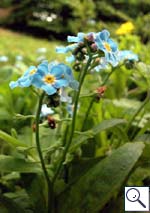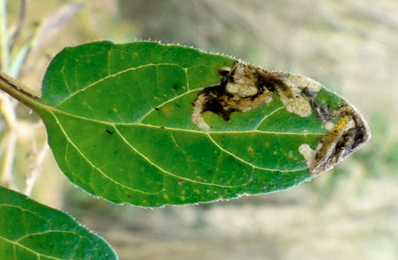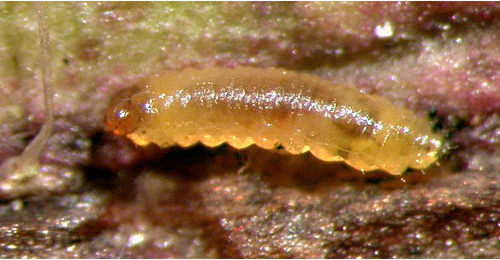|
||||||
|
MYOSOTIS. Forget-me-nots. [Boraginaceae] |
|
|
Thirteeen species of Myosotis are recorded in Britain. These include the native Field Forget-me-not (M. arvensis), Changing Forget-me-not (M. discolor), Early Forget-me-not (M. ramosissima), Jersey Forget-me-not (M. sicula), Tufted Forget-me-not (M. laxa), Water Forget-me-not (M. scorpioides), Creeping Forget-me-not (M. secunda), Pale Forget-me-not (M. stolonifera), Alpine Forget-me-not (M. alpestris) and Wood Forget-me-not (M. sylvatica). The BSBI provide a downloadable plant crib for Myosotis. Ten British miners are recorded on Myosotis. A key to the European miners recorded on Myosotis is provided in Bladmineerders van Europa.
|
 Water Forget-me-not Myosotis scorpioides |
Key for the identification of the known mines of British |
|
|
Note: Diptera larvae may live in a corridor mine, a corridor-blotch mine, or a blotch mine, but never in a case, a rolled or folded leaf, a tentiform mine or sandwiched between two more or less circular leaf sections in later instars. Pupation never in a cocoon. All mining Diptera larvae are leg-less maggots without a head capsule (see examples). They never have thoracic or abdominal legs. They do not have chewing mouthparts, although they do have a characteristic cephalo-pharyngeal skeleton (see examples), usually visible internally through the body wall. The larvae lie on their sides within the mine and use their pick-like mouthparts to feed on plant tissue. In some corridor miners frass may lie in two rows on alternate sides of the mine. In order to vacate the mine the fully grown larva cuts an exit slit, which is usually semi-circular (see Liriomyza huidobrensis video). The pupa is formed within the hardened last larval skin or puparium and as a result sheaths enclosing head appendages, wings and legs are not visible externally (see examples). See Key to non-Diptera. |
|
1a > Leaf-miner: A narrow linear leaf-mine, which developes into a large blotch. Several larvae frequently feed together and the resulting mine can entirely fill the leaf (Spencer, 1976: 89). The mine begins with a narrow, parallel sided corridor af 1-8 cm in length, with a nice double frass line. After the first moult the corridor is succeeded, and mostly overrun, by a large, primary, brown blotch. Frass in the initial corridor in short thread fragments, in the blotch in angular granules and thread fragments that often are branching (the frass is unusally sticky). Primary and secondary feeding lines conspicuous. The final mine often is very large and generally contains several larvae, because normally several mines develop on a leaf, and coalesce into one big blotch. Before pupation the larvae leave the mine through a semicircular exit slit that mostly, but not invariably, is in the upper epidermis. The initial narrow gallery contains frass in a double line. It then expands to form a blotch mine. Several larvae may occupy a leaf to form a large blotch. |
|
|
|
Agromyza abiens Zetterstedt, 1848 [Diptera: Agromyzidae]. |
|
1b > Leaf-miner: Larvae forming large blotch mine (Spencer, 1972b: 32 (fig. 87), 35). Spencer's (1963a) description of the mine is rather succinct: "beginning with a narrow channel, then developing into a distinctive blotch, filled centrally with blackish frass; the mine does not occupy the entire leaf." In the figure he adds the initial corridor follows the leaf margin. Robbins (1991), without mentioning a source, adds that the mine resembles that of A. pseudorufipes, and that pupation is outside the mine. The mine is also illustrated in the Encyclopedia of Life. |
|
|
|
Agromyza lithospermi Spencer, 1963 [Diptera: Agromyzidae]. |
|
1c > Leaf-miner: A large, irregular blotch mine with a short linear section in the first instar which is frequently entirely enveloped in the fully developed mine and may then be no longer visible (Spencer, 1976: 124). Perhaps the only character differentiating it from abiens is the presence of several larvae in a fully developed mine of abiens and just one in myosotidis. Puparium reddish brown |
|
|
|
Agromyza myosotidis Kaltenbach, 1864 [Diptera: Agromyzidae]. |
|
1d > Leaf-miner: A large blotch, larva frequently entering a second leaf to complete development (Spencer, 1972b: 35). Single larva. Primary and secondary feeding lines indistinct. Frass in short thread fragments. Pupation outside the mine; exit slit upper-surface. |
|
|
|
Agromyza pseudorufipes Nowakowski, 1964 [Diptera: Agromyzidae]. |
|
1e > Leaf-miner: Mine initially linear, later developing into a whitish blotch. Pupation in mine on lower surface (Spencer, 1972b: 90). Rather small upper-surface secondary blotch in the leaf apex, generally beginning with a short corridor that mostly is overrun by the later blotch. No feeding lines recognisable. The final part of the mine is a lower-surface corridor, mostly following a vein and containing no frass. At its end an exit slit is made; mostly the larva pupariates within the mine, just before the exit. |
|
|
|
Phytomyza myosotica Nowakowski, 1959 [Diptera: Agromyzidae]. |
|
1f > Leaf-miner: Full depth, initially a much branched corridor, irregular in width, in the end almost a blotch. The mine has openings by which part of the frass is ejected. The larvae frequently leave the mine to restart elsewhere. Older larva live free and cause window feeding, often erasing their old mines. In Coltsfoot also pseudo-mines are made, when the larva eats away the lower epidermis with the leaf tissue, but spares the dense hair cover. |
|
|
|
Phytosciara halterata Lengersdorf, 1926 [Diptera: Sciaridae]. |
|
|
Key for the identification of the known mines of British |
Note: The larvae of mining Coleoptera, Hymenoptera and Lepidoptera may live in a corridor mine, a corridor-blotch mine, a blotch mine, a case, a rolled or folded leaf, a tentiform mine or sandwiched between two more or less circular leaf sections in later instars. Larva may pupate in a silk cocoon. The larva may have six legs (although they may be reduced or absent), a head capsule and chewing mouthparts with opposable mandibles (see video of a gracillarid larva feeding). Larvae of Hymenoptera and Lepidoptera usually also have abdominal legs (see examples). Frass, if present, never in two rows. Unless feeding externally from within a case the larva usually vacates the mine by chewing an exit hole. Pupa with visible head appendages, wings and legs which lie in sheaths (see examples). |
1a > Leaf-miner and case-bearer: The larva lives outside the mine, protected by a case, and feeds on the underlying plant tissues via a hole cut in the epidermis. From that point it eats away as much leaf tissue as it can reach without fully entering the mine. Mine does not contain frass (Coleophora species) |
1b > Leaf-miner, but not a case-bearer: The larva lives mainly inside the mine. Mine usually contains frass. In later instars the larva may live sandwiched between two more or less circular sections cut from the leaf. |
2 > Leaf-miner and case-bearer: The larva feeds in a distinctive case made from hairy leaf fragments of the foodplant. The young larva feeds on the developing seeds and hibernates in its first case which is made of the tip of a petal. After hibernation it makes a hoary, laterally flattened composite leaf case (resembling a willow catkin). Full depth mines are made at the margin of the leaves, that thereby look peculiarly damaged. Mouth angle 70°. Initially forms a blotch mine, in the centre of a leaf, which it excises for its initial case. In the spring it repeatedly extends its case and it resembles a jagged catkin of willow. The larva may wander from its foodplant and attach to other plants or fences etc. |
|
Coleophora pennella (Denis & Schiffermüller, 1775) [Lepidoptera: Coleophoridae]. |
3a > Leaf-miner: Mine upper-surface or, more often, lower-surface. At first a long, narrow, winding epidermal gallery with central, more or less deliquescent, reddish brown frass. The gallery abruptly widens into an elongate blotch that is epidermal at first but soon deeper; the blotch is brown with strikingly white margins. Epidermis finely wrinkled. Lower surface mines strongly contract the leaf (and often there is a mine at either side of the midrib). 2-3 Larvae in a blotch, each with its own initial corridor. Frass in large black grains in a central depot; moreover in the form of very thin threads stuck in a reticulate pattern in the epidermis. |
|
Dialectica scalariella (Zeller, 1850) [Lepidoptera: Gracillariidae]. |
3b > Leaf-miner: In the first instar the larva mines the leaves, forming short, irregular, blotch-like mines, but in later instars it lives externally, feeding in spun leaves and often twisting those of tender shoots. Larval head light-brown or yellowish brown, edged with black postero-laterally, ocellar area blackish; prothoracic plate black edged with whitish anteriorly; abdomen dull dark green; pinacula distinct, black, sometimes brownish but with black bases to setae; anal plate large, black (Bradley et al., 1973). Small, full depth mine without a definite shape; little frass. Some silk is deposited in the mine. The larva soon leaves the mine and continues feeding among spun leaves. |
|
Cnephasia incertana (Treitschke, 1835) [Lepidoptera: Tortricidae]. |
3c > Leaf-miner: Rather narrow corridor, untidy and sometimes branched, starting from the base of the leaf, in particular the midrib. Sides of the corridor irregularly eaten out, not really parallel. Frass mostly present, and then in a central line. The larva is capable of leaving the mine and start a new one elsewhere. These later mines are much broader, and the frass is scattered irregularly.. |
 Mine of Orthochaetes insignis on Prunella vulgaris Image: © Jean-Yves Baugnée (Bladmineerders van Europa) |
|
Orthochaetes insignis (Aube, 1863) [Coleoptera: Curculionidae]. |
3d > Leaf-miner: The mine begins in the midrib, especially in a lower leaf, extending into the leaf disc, branching irregularly or pinnately, may also locally be blotch like. The mine is brown and very transparent. Sides very irregularly eaten out. Frass loosely dispersed or in a loose central line, buy may also be pressed against the sides of the corridor. The larva may also leave the mine and restart elsewhere. |
 Orthochaetes setiger larva, dorsal Image: © Jean-Yves Baugnée (Bladmineerders van Europa) |
|
Orthochaetes setiger (Beck, 1817) [Coleoptera: Curculionidae]. |
| Last updated 06-Jul-2019 Brian Pitkin | ||
